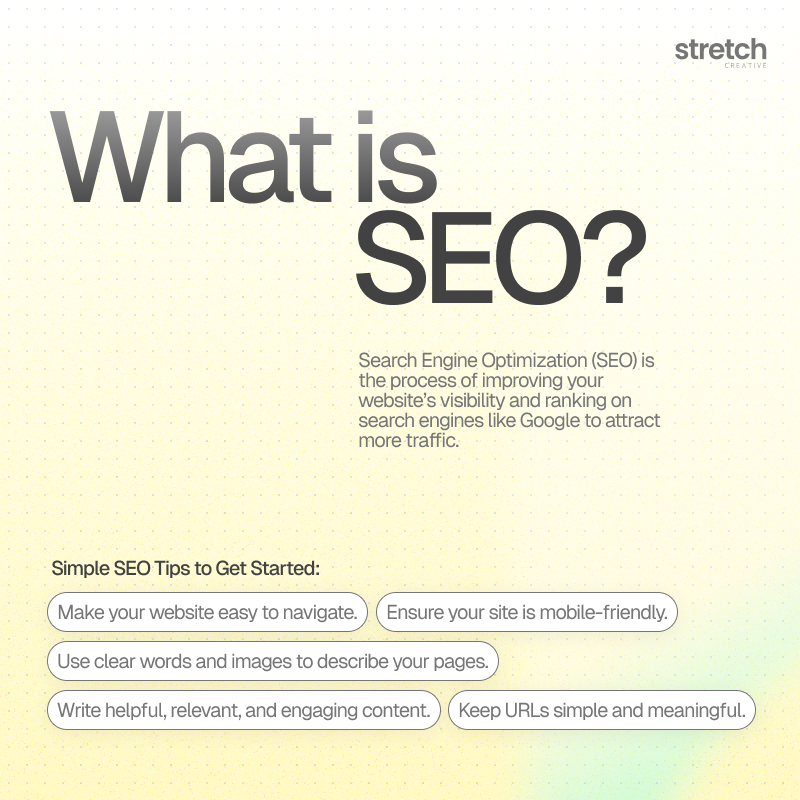
A while back, an electrical engineer friend of mine tried explaining how electricity works. No matter how hard I tried to pay attention, the concepts just wouldn’t stick. Honestly, SEO for small teams feels pretty similar. The details can get complex, but you don’t need to understand all the electrical currents or algorithmic formulas to get the lights to turn on.
What you do need is a basic understanding of SEO—just enough to light up your small business, boost your website’s traffic, and watch your organic traffic climb. It’s like flipping a switch: once you’ve got the basics down, the results will start to shine.
This article is written for small marketing teams, small businesses, or even solo marketers who need to understand SEO well enough to avoid wrecking their website and to start seeing the benefits of being found on Google.
Table of Contents
What is SEO, really?

SEO stands for “Search Engine Optimization.” In simple terms, it’s the process of boosting your website’s visibility and rankings in search engine results pages (SERPs). The goal? Drive more organic traffic by making sure your website ranks well for the keywords or phrases that matter most to your audience. The better your SEO, the more chances you have to attract visitors, improve brand awareness, engage customers, and (fingers crossed!) increase conversions.
Brief history of SEO
SEO has come a long way since the early days of the internet. Back in the 1990s, search engines like Altavista and Yahoo! were the go-to tools for finding information online. As the internet grew, so did the need for better ways to rank websites. By the late 1990s, search engines began using algorithms to determine the relevance and quality of web pages. This marked the beginning of SEO as we know it. Fast forward to the early 2000s, and SEO has become a vital part of digital marketing. Today, it’s a multi-billion dollar industry, with businesses and individuals vying for those coveted top spots in search engine results.
Importance of SEO for Small teams in digital marketing
In the realm of digital marketing, SEO changes the game. It helps businesses and individuals connect with their target audience by driving qualified traffic to their websites. By optimizing your site for search engines, you can boost your online visibility, build brand awareness, and ultimately drive conversions. In essence, a well-executed SEO strategy can be the cornerstone of your digital marketing efforts, delivering long-term benefits and a solid return on investment.
Understanding search engines
Search engines serve as your digital gatekeepers, helping people find content online. They crawl, index, and rank websites based on factors like relevance, authority, and user experience. While Google is the heavy hitter in the search engine world, Bing, Yahoo, and DuckDuckGo still get some love from certain crowds.
Knowing what search engines look for means you can optimize your site to meet those criteria and increase your chances of ranking higher. The key to success is giving search engines exactly what they’re after—after all, they’re the ones who help users find your website.
SEO for Small Teams — Crawling, indexing, and ranking
To understand how search engines display search results, it’s essential to grasp the processes of crawling, indexing, and ranking. Crawling is the first step, where search engines scour the web to discover new content. Once found, this content is indexed, meaning it’s stored and organized in a massive database. Finally, the ranking process determines the relevance and authority of the indexed content, deciding where it appears in search results. Search engines use complex algorithms to rank websites, considering factors like keyword usage, link equity, and user experience. By optimizing for these factors, you can improve your chances of ranking higher in search results.
Understanding search engine algorithms
Search engine algorithms are the secret sauce behind how websites are ranked in search engine results. These complex systems evaluate numerous factors to determine a site’s relevance and authority. One of the most famous algorithms is Google’s PageRank, which assesses link equity to gauge a website’s importance. Other notable algorithms include Google’s Panda, which focuses on content quality, and Penguin, which targets link spam. Understanding these algorithms is crucial for SEO success. By aligning your website and content with what these algorithms prioritize, you can enhance your rankings and drive more organic search traffic.
How to not mess it all up
It’s always easier to build things the right way from the start, but if you’ve already got a website that’s not quite SEO-friendly, don’t panic—you can absolutely fix it. The best way to approach this is to think like your user. Ask yourself:
- What’s the easiest way for visitors to navigate my website?
- Do my pages explain what they’re about with both words and images?
- Is my content helpful, relevant, and—dare I say—interesting?
- Are my URLs clear and meaningful?
- Does the overall structure of my website make sense?
- Is my website mobile-friendly?
By addressing these fundamental elements, you’re already ahead of the game. And guess what? You’ve just set yourself up for SEO success.
Ready to Take It to the Next Level?
If you’ve got the basics down and you’re ready to go beyond just the foundational steps, Stretch can help you take things up a notch. Whether you need help with SEO, content strategy, or overall digital marketing, we’re here to help. Reach out today for a free consultation, and let’s chat about how we can help you grow your business with a solid SEO strategy.